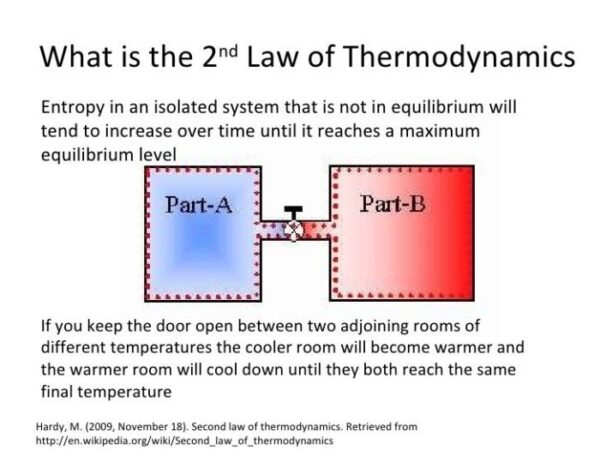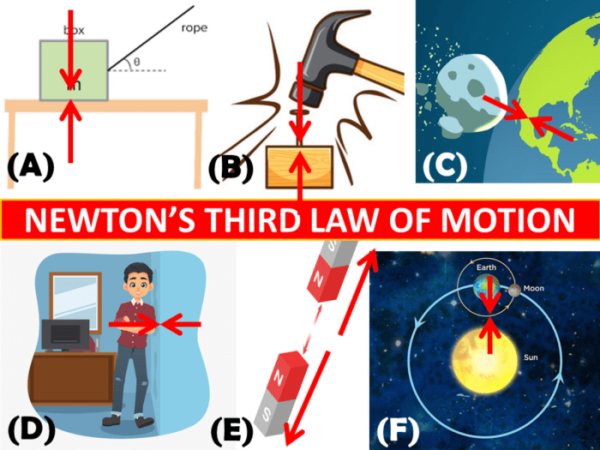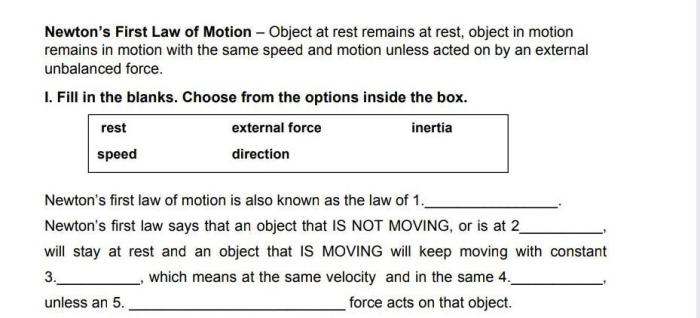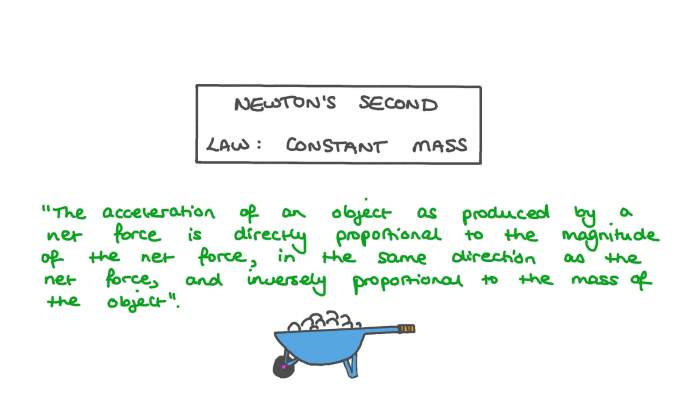
What is newtons third law – What is Newton’s Third Law of Motion? It’s a fundamental principle that governs how objects interact in the universe. This law, formulated by Sir Isaac Newton, explains the concept of forces and how they act in pairs. You’ve likely experienced this law in action without even realizing it – think about jumping on a trampoline or pushing off from a wall to propel yourself forward. Let’s dive into the fascinating world of Newton’s Third Law and explore its impact on our daily lives.
Newton’s Third Law states that for every action, there is an equal and opposite reaction. This means that when one object exerts a force on another object, the second object exerts an equal and opposite force back on the first object. These forces always occur in pairs, acting on different objects, and are always equal in magnitude but opposite in direction. This simple yet profound principle has far-reaching implications in physics and engineering, explaining everything from rocket propulsion to the way we walk.
Introduction to Newton’s Third Law
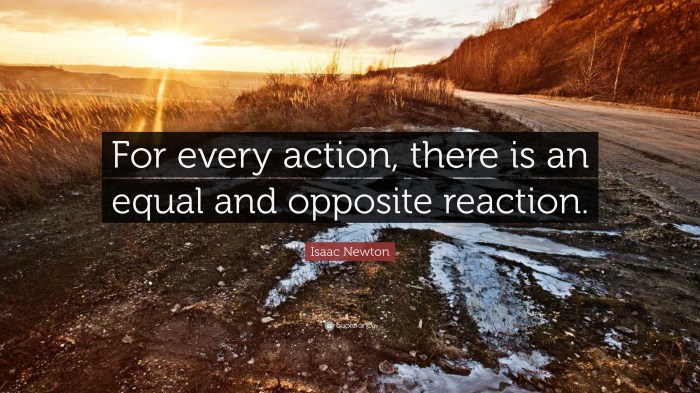
Newton’s Third Law of Motion, often stated as “for every action, there is an equal and opposite reaction,” is a fundamental principle in physics that governs the interactions between objects. This law describes how forces always occur in pairs, and the understanding of these paired forces is crucial for comprehending various phenomena in our world.
This law, formulated by Sir Isaac Newton in his groundbreaking work *Philosophiæ Naturalis Principia Mathematica* (Mathematical Principles of Natural Philosophy), published in 1687, has profoundly influenced our understanding of motion and its implications in diverse fields, from everyday experiences to complex engineering designs.
Real-World Examples of Newton’s Third Law, What is newtons third law
Newton’s Third Law is evident in numerous everyday occurrences. These examples illustrate how the law operates in practical scenarios, making it relatable and understandable.
- Walking: When you walk, you push backward on the ground with your feet. In response, the ground pushes forward on you with an equal and opposite force, propelling you forward.
- Swimming: A swimmer pushes water backward with their arms and legs. The water, in turn, exerts an equal and opposite force forward, propelling the swimmer through the water.
- Rocket Launch: A rocket expels hot gases downward. The gases exert an upward force on the rocket, launching it into space.
- Jumping: When you jump, you push down on the ground with your feet. The ground pushes back up on you with an equal and opposite force, launching you into the air.
Key Concepts and Definitions: What Is Newtons Third Law
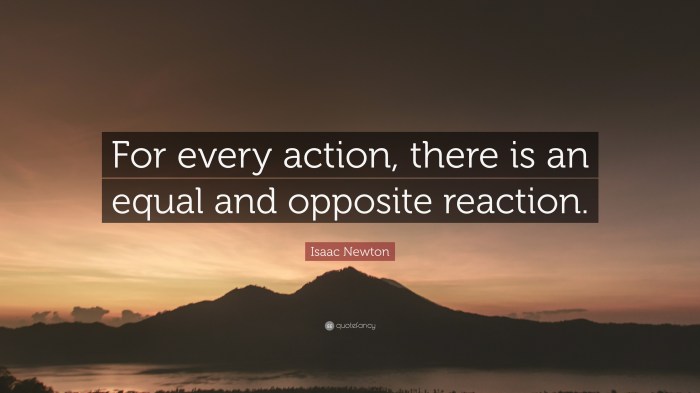
Newton’s Third Law of Motion introduces fundamental concepts that are essential for understanding how forces interact in the physical world. These concepts provide a framework for analyzing motion and predicting how objects will behave under the influence of forces.
Action and Reaction Forces
Newton’s Third Law states that for every action, there is an equal and opposite reaction. This means that whenever one object exerts a force on another object, the second object exerts an equal and opposite force back on the first object. These forces are known as action and reaction forces.
“For every action, there is an equal and opposite reaction.” – Sir Isaac Newton
To understand these concepts, let’s consider some examples:
* Walking: When you walk, your foot pushes backward on the ground (action force). In response, the ground pushes forward on your foot (reaction force). This reaction force propels you forward.
* Swimming: When you push water backward with your arms and legs (action force), the water pushes you forward (reaction force), allowing you to swim.
* Jumping: When you jump, your legs exert a downward force on the ground (action force). The ground, in turn, exerts an upward force on your legs (reaction force), propelling you into the air.
Equal and Opposite Forces
The concept of “equal and opposite forces” is central to Newton’s Third Law. It means that the action and reaction forces have the same magnitude (strength) but act in opposite directions.
For instance, if you push a wall with a force of 100 Newtons, the wall will push back on you with a force of 100 Newtons in the opposite direction. This principle applies to all interactions between objects, regardless of their size or mass.
Direction of Forces
Understanding the direction of forces is crucial for applying Newton’s Third Law effectively. The action and reaction forces always act on different objects and act in opposite directions.
For example, when a rocket launches, it expels hot gases downward (action force). The gases, in turn, exert an upward force on the rocket (reaction force), propelling it into the air. The direction of the action force is downward, while the direction of the reaction force is upward.
Applications of Newton’s Third Law
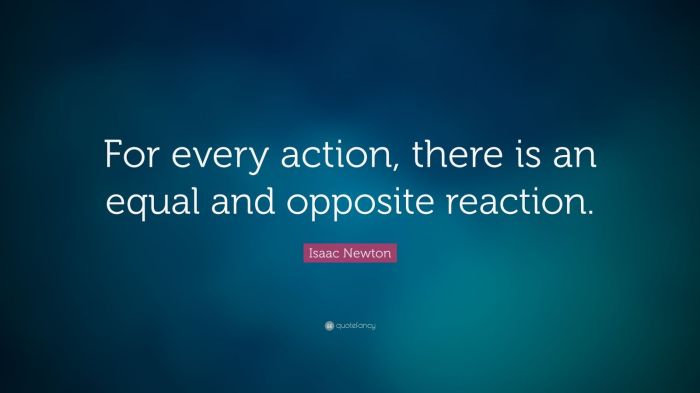
Newton’s Third Law, with its simple yet profound statement, has far-reaching implications in our everyday lives and various scientific disciplines. It explains the fundamental principle of action and reaction forces, shaping our understanding of motion, stability, and numerous technological advancements.
Everyday Applications
Newton’s Third Law is evident in countless everyday scenarios. When you push against a wall, the wall pushes back on you with an equal and opposite force. This is why you don’t fall through the wall. Similarly, when you walk, your feet push against the ground, and the ground pushes back, propelling you forward.
- Walking: As you take a step, your foot exerts a force on the ground. The ground, in turn, exerts an equal and opposite force on your foot, propelling you forward.
- Swimming: Swimmers push water backward with their arms and legs. The water, in response, pushes the swimmer forward.
- Jumping: When you jump, you exert a force on the ground. The ground exerts an equal and opposite force on you, launching you into the air.
- Rowing a Boat: Rowers use oars to push against the water. The water pushes back on the oars, propelling the boat forward.
Applications in Engineering and Physics
Newton’s Third Law is a cornerstone of engineering and physics, playing a crucial role in the design and analysis of various systems. It is fundamental to understanding:
- Structural Engineering: Engineers use the principles of action and reaction forces to design stable structures. Buildings, bridges, and other structures must be able to withstand the forces exerted on them by their surroundings and occupants.
- Machine Design: Understanding the interplay of forces is essential in designing machines, from simple gears to complex engines. Each component exerts forces on others, and these forces must be carefully balanced for optimal performance.
- Collision Analysis: In traffic accidents, Newton’s Third Law helps explain the forces involved in collisions. The impact forces between vehicles are equal and opposite, influencing the severity of the collision and the resulting damage.
Rocket Propulsion
One of the most dramatic applications of Newton’s Third Law is in rocket propulsion. Rockets work by expelling hot gases out of their engines. These gases exert a force on the rocket in the opposite direction, propelling it forward.
“For every action, there is an equal and opposite reaction.”
This principle is evident in the way rockets launch into space. The rocket’s engines burn fuel, producing hot gases that are expelled out of the nozzle at high velocity. These gases exert a force on the rocket in the opposite direction, pushing it upward. The faster the gases are expelled, the greater the force on the rocket, and the faster it accelerates.
Other Advanced Technologies
Newton’s Third Law is also crucial in other advanced technologies, such as:
- Jet Engines: Jet engines operate based on the same principle as rocket engines. Air is compressed and heated, then expelled out of the engine, creating thrust.
- Helicopters: Helicopters use rotating blades to push air downward. The air, in turn, pushes the blades upward, providing lift.
- Hovercrafts: Hovercrafts use powerful fans to create a cushion of air beneath the vehicle, allowing it to float above the ground. The air pushed downward by the fans exerts an equal and opposite force, lifting the hovercraft.
Final Summary
Newton’s Third Law of Motion is a powerful concept that helps us understand the intricate interplay of forces in the universe. It is a foundational principle in physics, with applications ranging from everyday experiences to complex technological advancements. By grasping this law, we gain a deeper appreciation for the interconnectedness of objects and the forces that govern their interactions. So, the next time you jump on a trampoline, remember the invisible forces at play, thanks to the wisdom of Sir Isaac Newton.
FAQ Corner
What are some real-world examples of Newton’s Third Law?
Examples include swimming (pushing water backward propels you forward), walking (pushing on the ground with your feet propels you forward), and the recoil of a gun (the bullet pushing forward causes the gun to recoil backward).
Does Newton’s Third Law apply to all forces?
Yes, it applies to all forces, including gravitational, electromagnetic, and frictional forces. For every force, there is an equal and opposite force acting on a different object.
Why is Newton’s Third Law important?
It is crucial for understanding how objects interact and move. It forms the basis for many other physical laws and has applications in various fields, including engineering, aerospace, and robotics.
Can Newton’s Third Law be used to explain why objects fall to the ground?
While Newton’s Third Law is involved in the interaction between the Earth and a falling object, the primary reason for falling is gravity, not Newton’s Third Law directly. The Earth exerts a gravitational force on the object, and the object exerts an equal and opposite gravitational force on the Earth. However, the Earth’s much larger mass means the object accelerates towards the Earth, not the other way around.
